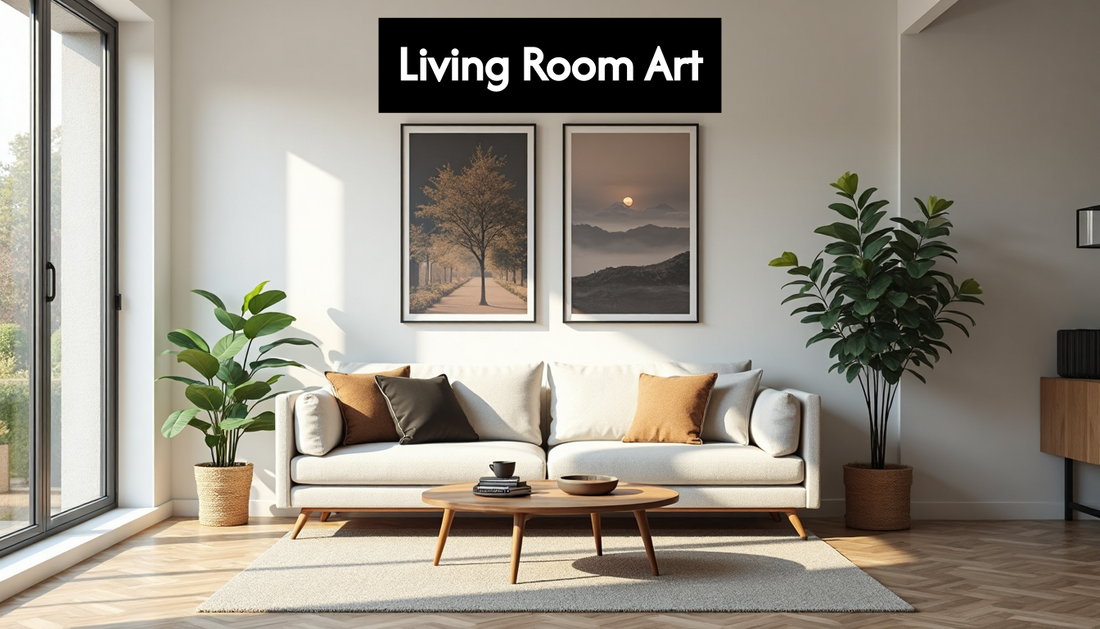
How to Choose Art for Living Room Walls: 2025 Guide
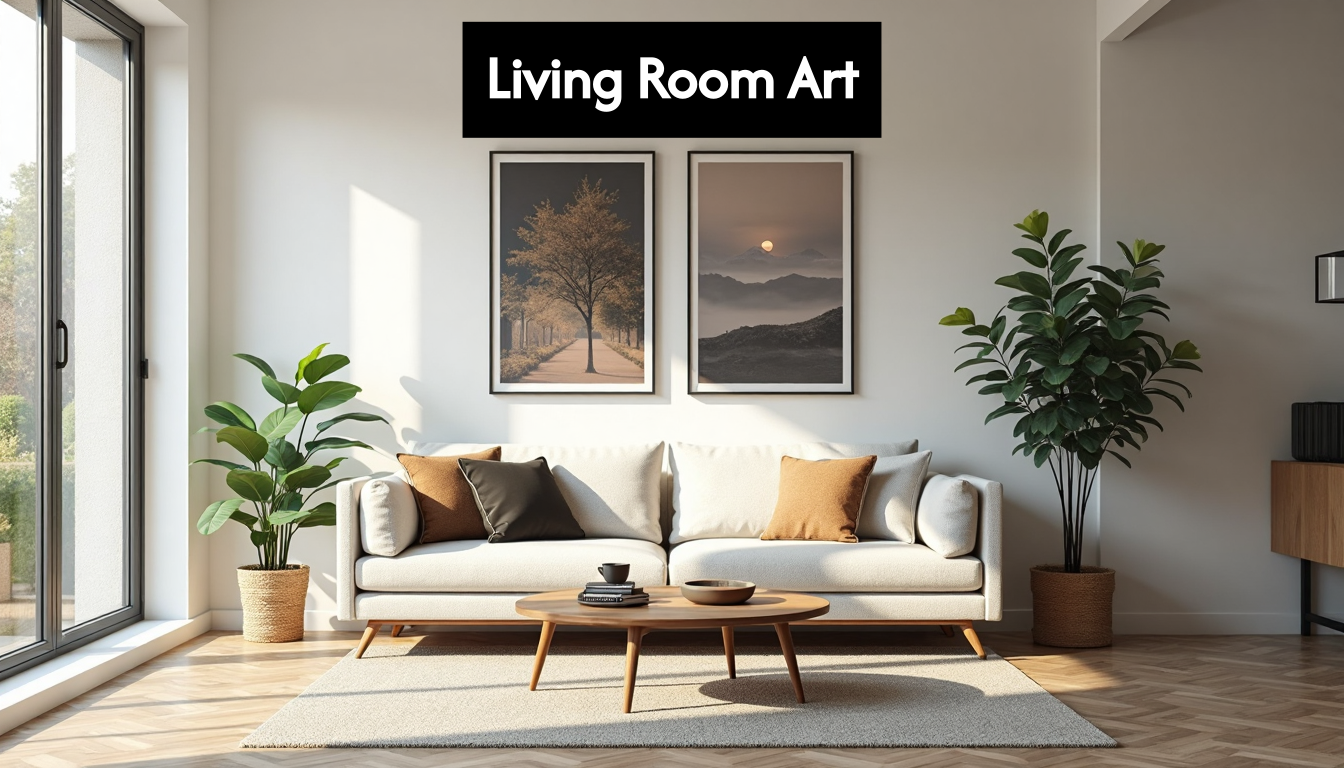
Choosing art for your living room goes way beyond picking a pretty picture. Designers now recommend that your wall art should fill about 60 to 75 percent of your available wall space for the best visual balance. Most people expect a splash of color or a matching frame to do the trick. Surprisingly, the latest trends favor mixing bold personal expression with your existing decor, even if that means breaking the supposed rules for harmony. The right art can reshape your space and make it feel like no one else’s, and with new digital platforms, discovering unique pieces has never been easier.
Table of Contents
- Understanding Your Living Room Style
- Selecting Art Types: Canvas, Prints, And More
- Tips For Choosing The Right Size And Placement
- Supporting Independent Artists And Finding Unique Pieces
Quick Summary
| Takeaway | Explanation |
|---|---|
| Understand Your Living Room Style | Analyze your design aesthetic, color palette, and the balance between personal expression and design cohesion before selecting art. |
| Select the Right Art Type | Choose from diverse mediums like canvas art, mixed media, or photography that match your aesthetic and resonate with personal storytelling. |
| Consider Size and Placement | Aim for artwork that occupies 60%-75% of the wall space, and hang art at eye level (57-60 inches) for optimal visual balance. |
| Support Independent Artists | Explore digital platforms that showcase independent artists, providing unique pieces and opportunities for customization, while ensuring fair compensation. |
| Create a Cohesive Display | Use strategic arrangements, matching frames, and spacing to create a unified look when displaying multiple artworks. |
Understanding Your Living Room Style
Choosing art for your living room begins with a deep understanding of your personal interior design style. Your living space is more than just a room - it’s a canvas that reflects your personality, experiences, and aesthetic preferences. In 2025, interior design experts emphasize the critical importance of selecting artwork that harmonizes with your existing decor while making a unique statement.
Identifying Your Design Aesthetic
Before selecting artwork, take a moment to analyze your living room’s current style. Interior design trends for 2025 reveal that spaces are moving beyond rigid categorizations, embracing more fluid and personalized design approaches. Are you drawn to minimalist clean lines, bohemian eclectic vibes, industrial chic, or classic farmhouse charm? Each style demands a different approach to wall art.
Minimalist spaces typically benefit from bold, singular statement pieces that create visual interest without cluttering the environment. Boho interiors welcome mixed media, vibrant colors, and layered artwork that tells a story. Industrial styles pair well with abstract pieces, metallic accents, and graphic prints that complement raw architectural elements.
Color Palette and Artistic Harmony
Your living room’s color scheme plays a pivotal role in art selection. Contemporary design trends suggest maintaining a clean, neutral base that allows curated artwork to become the focal point. This approach provides flexibility in selecting pieces that either complement or intentionally contrast with your existing color palette.
Neutral backgrounds like soft grays, warm whites, and muted earth tones create an ideal backdrop for both contemporary and classic art pieces. These versatile base colors allow you to experiment with bold artwork without overwhelming the space. Consider artwork that introduces complementary or accent colors that echo elements in your furniture, rugs, or decorative accessories.
Balancing Personal Expression and Design Cohesion
Art selection is a deeply personal journey that goes beyond mere decoration. Your chosen pieces should resonate with your emotional landscape while maintaining visual harmony within the room. The goal is not just to fill wall space but to create a narrative that speaks to your individual experiences and aesthetic sensibilities.
Consider creating a gallery wall that combines different sizes, styles, and mediums. This approach allows for personal storytelling while maintaining design cohesion. Mix photographic prints with abstract paintings, incorporate three-dimensional pieces, or blend vintage and contemporary artworks to create a dynamic visual experience that is uniquely yours.
Remember, there are no strict rules in art selection. The most important factor is choosing pieces that spark joy, provoke thought, and make you feel connected to your living space. Your living room’s art should be a reflection of your journey, your passions, and the stories you want to tell.
Selecting Art Types: Canvas, Prints, and More
Navigating the world of wall art requires understanding the diverse mediums available for transforming your living room. In 2025, art selection goes beyond traditional approaches, offering innovative options that cater to various aesthetic preferences and functional needs.
Canvas Art: The Timeless Classic
Contemporary design trends reveal that canvas art remains a quintessential choice for living room walls. These textured pieces provide depth and sophistication, with oversized abstract designs and nature-inspired prints leading the trend. Canvas art offers a unique advantage of creating visual dimension that flat prints cannot achieve.
When selecting canvas art, consider the texture, stretching technique, and framing. High-quality canvases feature gallery-wrapped edges, professional stretching, and archival-grade printing that ensures color longevity. You might explore pieces like our exclusive canvas collection that blend contemporary design with timeless artistic expression.
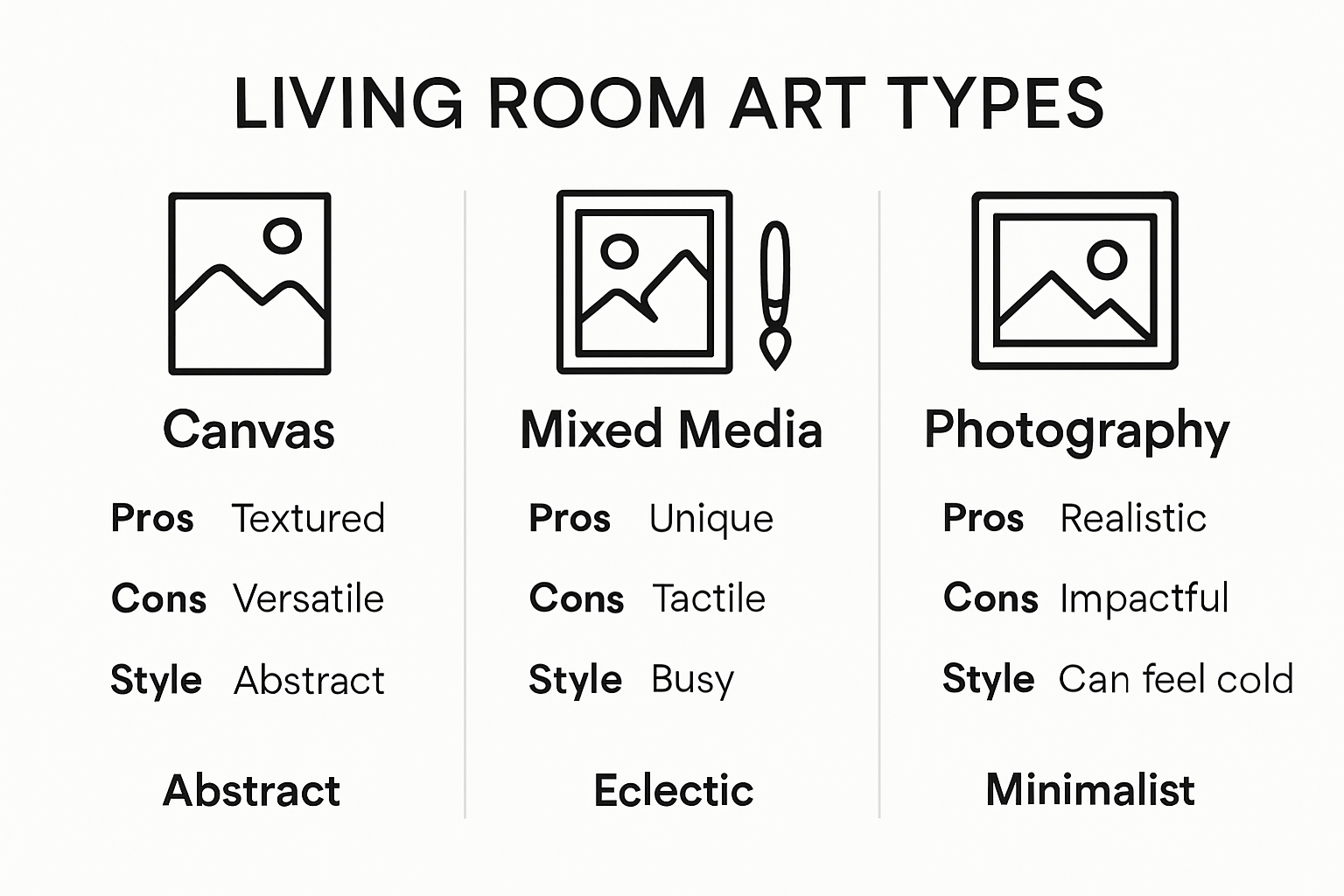
Mixed Media and Innovative Art Forms
Emerging art trends in 2025 highlight the growing popularity of three-dimensional and textured art pieces. These innovative formats go beyond traditional two-dimensional displays, creating immersive visual experiences. Three-dimensional wall sculptures, metallic installations, and mixed media artworks are transforming living spaces into dynamic galleries.
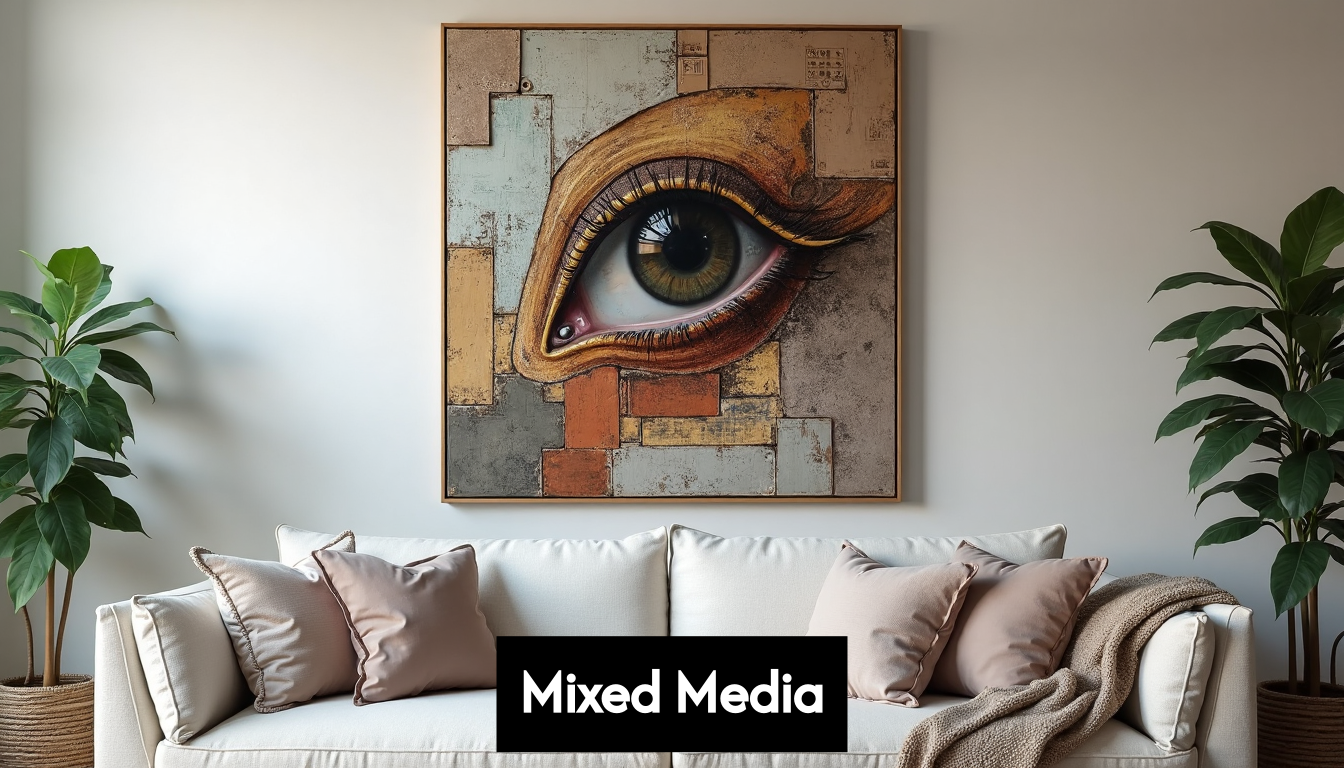
Consider incorporating pieces that combine different materials like wood, metal, ceramic, or fabric. These multidimensional artworks create visual interest and serve as conversation starters. Textured tapestries, metal wall sculptures, and layered canvas compositions can add depth and complexity to your living room’s aesthetic.
Photography and Graphic Prints
Photographic and graphic prints offer another compelling avenue for wall art selection. Interior design experts suggest that 2025 trends emphasize personal storytelling through visual mediums. Black and white photography, minimalist graphic designs, and curated photo collections provide versatile options for various design styles.
When selecting photographic or graphic prints, pay attention to paper quality, printing technique, and framing. Archival-grade paper, professional printing methods, and thoughtful framing can elevate a simple print into a sophisticated art piece. Consider creating a gallery wall that combines different sizes, styles, and subjects to create a personalized narrative within your living space.
Ultimately, the art you choose should resonate with your personal aesthetic and emotional landscape. Whether you opt for a single statement canvas, a collection of mixed media pieces, or a curated gallery wall, the goal is to create a space that feels authentically yours. Your living room art is not just decoration - it’s a reflection of your journey, experiences, and unique perspective.
Tips for Choosing the Right Size and Placement
Selecting the perfect artwork involves more than aesthetic appeal - it requires strategic sizing and precise placement to transform your living room into a visually harmonious space. Understanding the nuanced principles of art placement can elevate your interior design from ordinary to extraordinary.
Calculating Optimal Art Size
Professional design experts recommend that artwork should occupy approximately 60% to 75% of the available wall space. This guideline ensures visual balance without overwhelming the room’s existing decor. When selecting piece sizes, consider the dimensions of your walls and furniture to create proportional compositions.
For large wall spaces, consider statement pieces or gallery wall arrangements. Smaller walls benefit from more compact artworks or carefully curated collections. Measure your wall space carefully and use painter’s tape to outline potential artwork placement before making final decisions. This technique helps visualize how different sizes will interact with your room’s architectural elements.
Strategic Hanging Height and Positioning
Interior design research indicates that the ideal hanging height is typically 57–60 inches from the floor, which places the artwork’s center at average eye level. When positioning art above furniture, professional decorators suggest placing the bottom edge 6–8 inches above sofas, beds, or console tables.
For larger pieces or gallery walls, create visual anchors by aligning artwork with furniture edges or maintaining consistent spacing between pieces. Consider the room’s natural sight lines and traffic flow when determining placement. Avoid hanging art too high or too low, which can disrupt the room’s visual balance and make the space feel awkward.
Balancing Multiple Art Pieces
When displaying multiple artworks, create cohesion through strategic arrangement. Consider matching frames, complementary color schemes, or thematic connections between pieces. Symmetrical arrangements work well in formal spaces, while asymmetrical layouts suit more eclectic, contemporary interiors.
Experiment with different configurations like grid layouts, salon-style clusters, or linear arrangements. Maintain consistent spacing between pieces - typically 2–3 inches - to create a unified look. Digital tools and smartphone apps can help you plan gallery wall layouts before physically hanging artwork.
Remember that art placement is both a science and an art form. Trust your intuition while respecting fundamental design principles. Your living room should reflect your personality, telling a visual story that feels authentic and inviting. Take time to experiment, step back, and adjust until the arrangement feels perfect for your unique space.
Ultimately, the most important rule in art placement is to create an environment that brings you joy and makes you feel truly at home. Personal connection matters more than strict adherence to design guidelines.
Supporting Independent Artists and Finding Unique Pieces
In 2025, the art world has transformed dramatically, offering unprecedented opportunities to discover and support independent artists while curating truly unique living room art experiences. The digital landscape has revolutionized how art enthusiasts connect with creators, making it easier than ever to find distinctive pieces that tell a personal story.
The Rise of Digital Art Platforms
Market research reveals that digital transformation has enabled independent artists to connect directly with global buyers, creating a diverse ecosystem of original and limited-edition artworks. Online platforms have broken down traditional barriers, allowing artists to showcase their work beyond local galleries and giving consumers access to a global pool of creative talent.
When exploring independent artist collections, look for platforms that provide artist backgrounds, detailed artwork descriptions, and transparent pricing. Many digital platforms now offer exclusive canvas collections that highlight individual artists’ unique perspectives and techniques. These platforms not only support artists financially but also provide a more personal connection to the artwork you choose.
Exploring Customization and Unique Art Experiences
Emerging market trends indicate that customization and augmented reality (AR) technologies are transforming art buying experiences. Many platforms now offer virtual exhibitions and AR-enabled visualizers that allow you to preview artwork in your living room before making a purchase. These tools help you understand how a piece will interact with your existing decor, reducing the risk of selecting an artwork that doesn’t quite fit your space.
Consider exploring artists who offer custom commissions or limited edition prints. These pieces often carry a more personal narrative and can become conversation starters in your living room. Some artists specialize in creating artworks that can be tailored to specific color schemes, sizes, or themes, ensuring a perfect match for your interior design.
Ethical Art Collecting and Supporting Creativity
Supporting independent artists goes beyond simply purchasing artwork. It’s about understanding and valuing the creative process. Research the artists behind the pieces you love. Many independent creators share their inspirations, techniques, and personal journeys, adding depth to the artwork you bring into your home.
Look for platforms and artists that practice fair compensation and transparent pricing. Some digital marketplaces ensure that a significant portion of the sale goes directly to the artist, supporting their continued creative work. By choosing independent artists, you’re not just decorating your living room - you’re contributing to a global creative ecosystem and helping artists sustain their passion.
Remember that each piece of art represents more than a visual element. It’s a connection to a creator’s vision, a snapshot of their artistic journey, and a unique expression of creativity. Your living room becomes a gallery that tells a story - not just of design, but of human creativity and individual expression.
Frequently Asked Questions
How much wall space should art occupy in my living room?
Artwork should ideally fill about 60% to 75% of your available wall space to achieve the best visual balance.
What types of art are best for living room walls?
Consider canvas art, mixed media, photography, and graphic prints. Each type offers unique aesthetic qualities that can enhance your living room’s design.
What is the ideal height to hang art on the wall?
The optimal height for hanging art is typically 57-60 inches from the floor, making the artwork’s center visible at average eye level.
How can I support independent artists while decorating my living room?
Explore digital art platforms that feature independent artists, ensuring that your purchase contributes directly to their creative work while offering unique pieces.
Transform Your Living Room Walls Into an Expression of You
Struggling to find art that truly speaks to your style or fills that blank wall just right? You’re not alone. Many readers of our 2025 guide feel overwhelmed by the pressure to balance personal expression with cohesive design or the challenge of sizing art for their unique space. Choosing artwork that honors both your individuality and the proportions of your room can feel intimidating, but the right pieces can make your living space come alive.
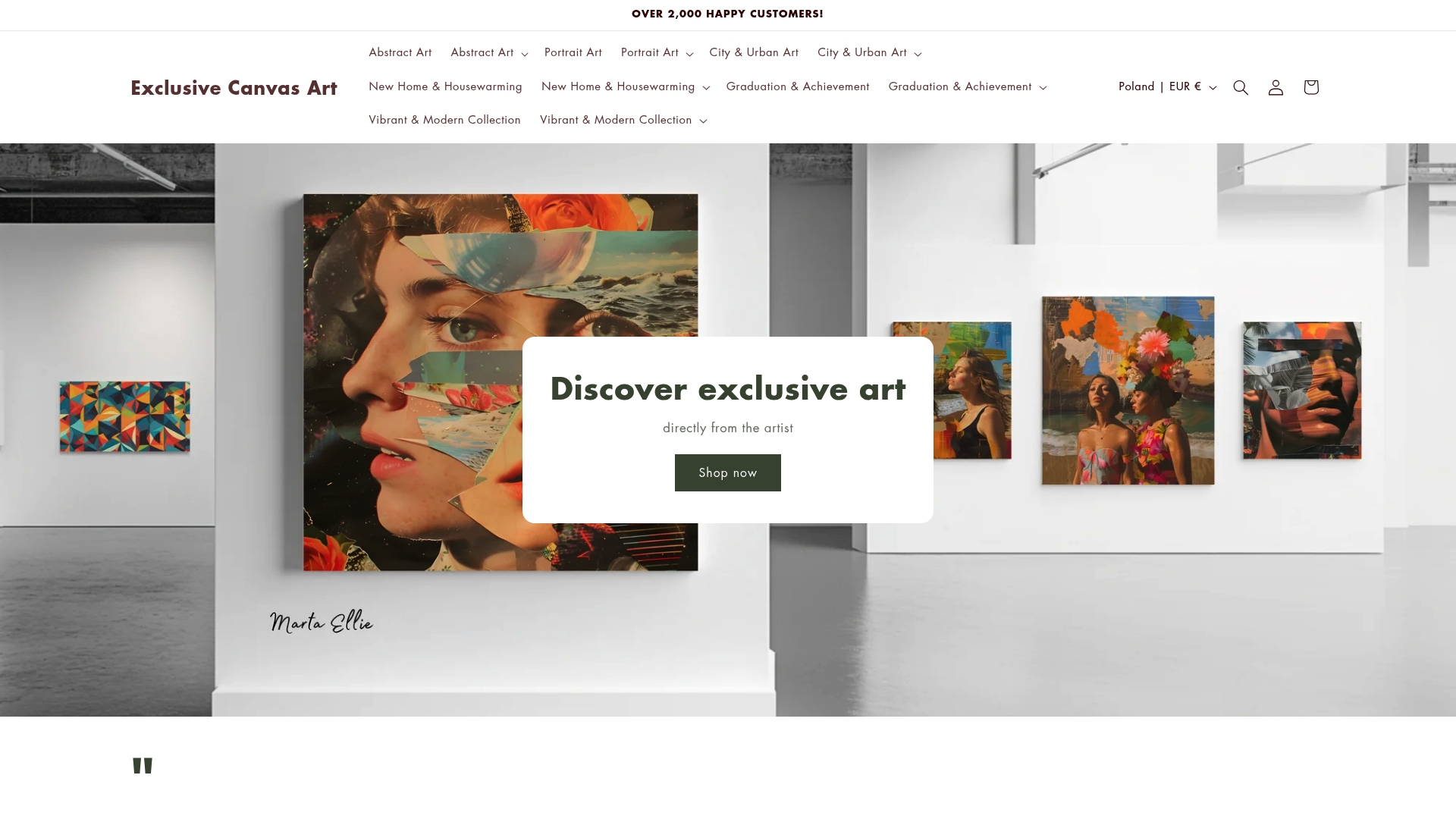
Take the guesswork out of your search and browse Marta Ellie’s exclusive canvas collection. Experience a curated selection designed to help you achieve the harmony, color balance, and visual impact highlighted in this article. Whether you are looking for bold abstracts or meaningful statement pieces that reflect your story, shop Marta Ellie’s unique wall art today for high-end options you can’t find anywhere else. Find the piece that belongs in your home and elevate your walls now.